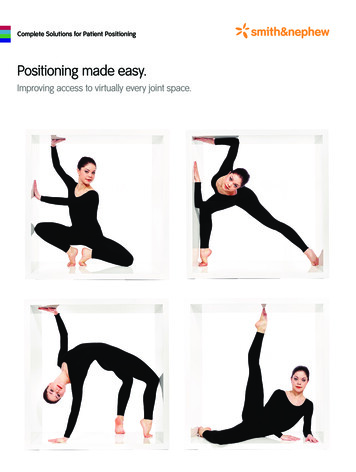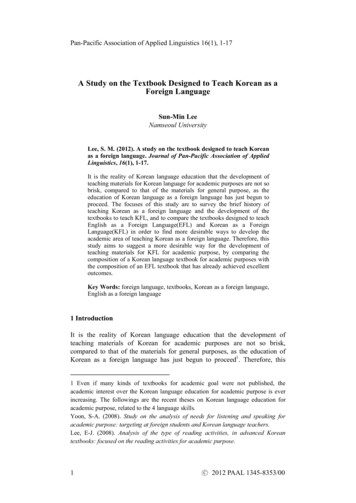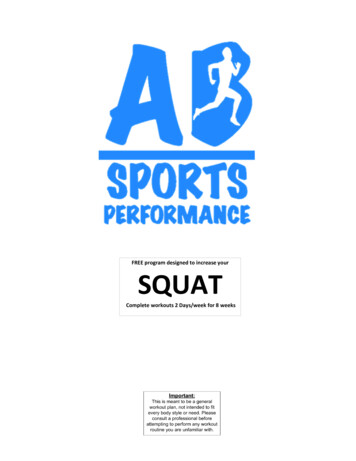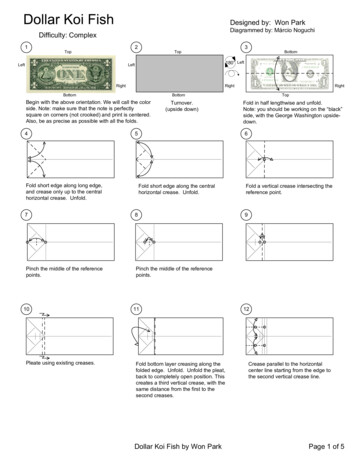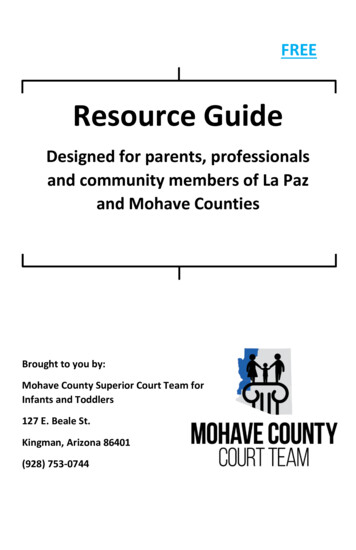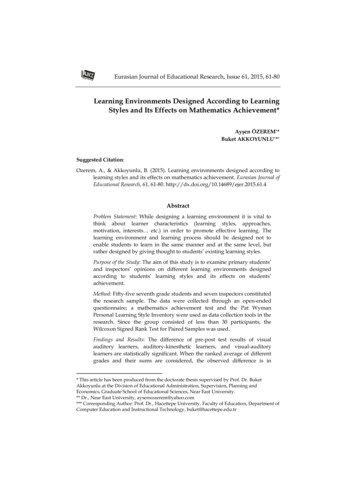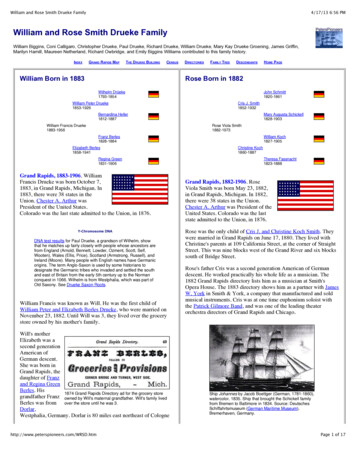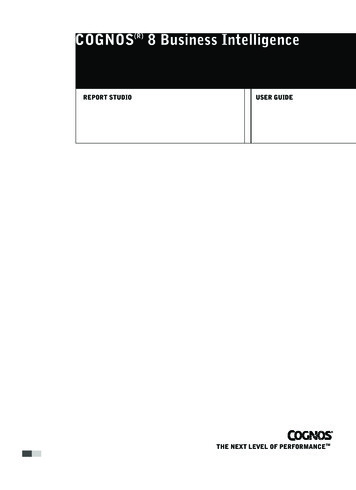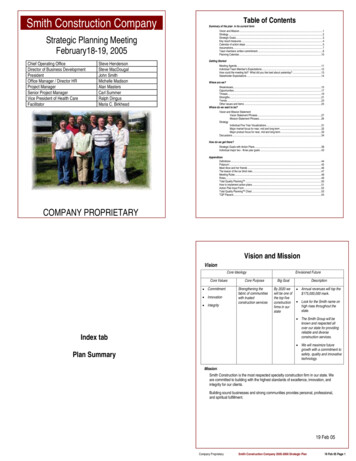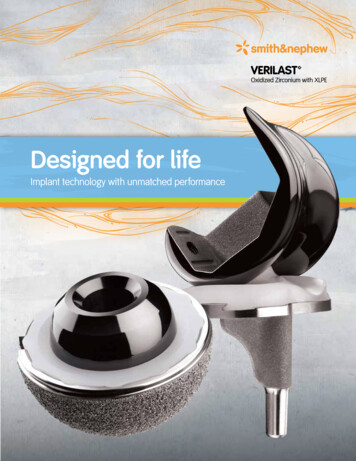
Transcription
Designed for lifeImplant technology with unmatched performance
Designed for life
Wear PerformanceBiocompatibilityReal-life results
Wear performanceAs today’s patients seek more active lifestyles than traditional patients, knee and hip implants will beexpected to endure more stress without succumbing to wear. However, the functional lifetime demandof younger and active patients is 10-fold greater than the estimated functional lifetime of traditionalpolyethylene.1 VERILAST Technology from Smith & Nephew is the only bearing technology withpublished results of 45 Million Cycles of hip and knee in vitro wear simulation testing, R3 Hip Systemand LEGION Primary Knee System, respectively. This means the replacement may be expected to provideimproved wear performance. More importantly, if implanted earlier, it may restore patients to their activelifestyles sooner.VERILAST Technology in the LEGION Primary KneeSystem demonstrates superior wear performance in 45million cycle testing.80% Reduction in Volumetric Wear70016081%140120VERILAST Technology R3 Hip System demonstratessuperior wear performance in 45 million cycle testing.Reduction in Volumetric Wear60060550012010067%Reduction in Volumetric Wear400803683006020040202301001220CoCr/CPE @ 5.0 McVERILAST @ 45 McComparison of the mean volumetric wear of CoCr/CPE aftersimulating 5 Mc of use and VERILAST after simulating 45 Mcrespectively.2CoCr/CPE@ 7.8 McCoCr/10-XLPE@ 45 McOxZr/10-XLPE@ 45 McComparison of the mean volumetric wear of CoCr/CPE andCoCr/XLPE at 7.8Mc and 45Mc respectively.3Multitude of optionsSmith & Nephew is the only company to offer VERILAST Technology. With the combination of OXINIUM alloyand highly cross-linked polyethylene (XLPE), VERILAST Technology offers a complete array of beneficial hipand knee implant options.Knee systemsHip systemsVERILAST Technology is available throughour GENESIS II, LEGION PRIMARY andJOURNEY II systems.VERILAST Technology is available through our R3Acetabular System, POLARCUP Dual Mobility System,and REFLECTION Acetabular System.
How many kneesystems havebeen lab-tested to30 years ofsimulated wear?‡Just one:LEGION Primary Knee Systemwith VERILAST TechnologyT he LEGION Primary CR Knee System completed 45 million cycles of in vitro simulated wear testing,which is an estimate of 30 years of activity. Other LEGION VERILAST Primary Knee Systems underwentsimilar lab testing comparable to industry standards. The results of in vitro wear simulation testinghave not been proven to quantitatively predict clinical wear performance. Also, a reduction in totalpolyethylene wear volume or wear rate alone may not result in improved clinical outcomes as wearparticle size and morphology are also critical factors in the evaluation of the potential for wear mediatedosteolysis and associated aseptic implant loosening. Particle size and morphology were not evaluatedas part of the testing.‡
Wear performanceVERILAST Technology for KneesVERILAST Technology is the peerless bearing combination of OXINIUM alloy and highlycross-linked polyethylene (XLPE). By combining the biocompatible, proprietary OXINIUMalloy with XLPE, Smith & Nephew’s VERILAST Technology in the LEGION and JOURNEY Knee Systems allow surgeons to address their patient’s knee pain earlier.When comparing Smith & Nephew’s conventional technology to its XLPE technology, theXLPE technology provides an expected, significant reduction in wear rates. Moreover,when comparing Smith & Nephew’s XLPE technology to VERILAST Technology, there isanother significant reduction in wear rates. Understanding these tests were conductedusing pristine components, the differences in these wear rates would be even morepronounced with roughened components due to the resistance to micro-scratches ofthe VERILAST couple.The implants identified below were tested by their manufacturers using different testingprotocols and, therefore, the results are not directly comparable.VERILAST Technology vs Conventional, XLPE and Anti-oxidant TechnologiesAll Trademarks acknowledged.
Metal sensitivityJust as metal ions are a well described problem for many hip replacement patients, cobalt, chromium andnickel are commonly cited allergens for knee replacement patients. In several cases, sensitivity to one ormore of the allergens has resulted in revisions for these patients.4-7Surgeons should be aware that all metal implants contain varying amounts of cobalt, chromium, and nickel.When selecting the appropriate implant, surgeons should consider the composition of each implant beforeuse. To help with this decision, VERILAST Technology incorporates proprietary OXINIUM alloy. Unlike cobaltchrome, OXINIUM alloy has 0.0035% nickel content and 0.02% chromium content.Metal content of implantsMaximum nickel content0.1%0.5%0.2%0.4%0.6%0.8%Ni content % by weightMaximum chromium content 0.02% 0.02%27-30%0.0%10%Clinical studies8Prevalence of patients demonstrating metal sensitivity 0.0035%0.0%920%Cr content % by weight30%40%
The perfectequation forhips
VERILAST Technology for HipsVERILAST Technology for hips from Smith & Nephew uses the exclusive bearing combination ofproprietary OXINIUM and highly cross-linked polyethylene, which provides superior clinical survivorshipand biocompatibility without sacrificing versatility or introducing the risk of ceramic-like fracture.19 Mostimportantly, VERILAST Technology provides low wear, corrosion avoidance and real-life results.Real-life resultsIn the 2014 Australian Registry, the ceramicised metal/ XL polyethylene category, which includes theexclusive OXINIUM alloy from Smith & Nephew, had the highest survivorship of all bearing categories at10 years: 96.7%. See the 2014 Australian Registry Results inserts to read more.**Although the ceramicised metal/ cross-linked polyethylene combination has the lowest reported cumulative percent revision at five yearsthis result should be interpreted with caution (Tables HT21 and HT24). It is the registry’s view that this articulation cannot be compared to otherarticulations as it has only been used with a small number of femoral stem and acetabuler combinations from a single company. The resultsshould not be compared due to the inability to correct for the confounding effect of the limited number of stem/acetabular combinations.Wear performanceAs patients today continue to go back to their active lifestyles, bearing longevity is more important. Wearreduction involving the bearing surfaces is critical to implant longevity. VERILAST Technology for total hiparthroplasty has been laboratory tested and shown to provide superior wear performance compared toCoCr on highly-crosslinked polyethelene, for up to 45 million cycles. With advanced materials designedto last, VERILAST Technology helps restore patients to their active lifestyles, allowing joint pain to beaddressed earlier.Cumulative volumetric wear comparison2700CoCr (32mm) against CPE600500CoCr (36mm) against 10-XLPE40080%300Reduction in volumetric wear after7.8 million cycles67%Reduction in volumetric wear after45 million cycles200100OxZr (36mm) against 10-XLPE001020304050
Corrosion avoidanceThere is a growing concern in the orthopaedic community about fretting and corrosion at the headneck taper junction. Recent studies have indicated that the choice of femoral head material can have amajor impact on the presence of corrosion in vivo. With its biocompatible properties, due to its use ofoxidized zirconium, VERILAST Technology has shown to reduce taper corrosion in total hip arthroplasty,minimizing the concern of trunnionosis. This makes VERILAST Technology the optimal solution for total hiparthroplasty.21-22A recent Rush University study compared Co-alloy, Ti-alloy, and Zr-Oxide alloy (OXINIUM ). This studyshowed that OXINIUM Technology produces less material debris. Additionally, it showed “less toxicity andinflammation in peri-implant cells than either Ti-alloy or Co-alloy, in vitro.”23A study by Pawar et al.21 used an acidic frettingtest to compare the potential corrosive and frettingresponses of OXINIUM (OxZr), cobalt chrome (CoCr)and stainless steel (StSt) femoral heads.MethodCoCr 4 head taper combinations were used: CoCr/ Ti64 OxZr/ Ti64 StSt/StSt OxZr/ StSt 3.5 pH solution used to submerge headneck junction Test run for over 5 Mcycles at 50 CTi64StStOxZrTi64OxZrStStStStImage from Pawar et al., ASMI 2004.“The OxZr heads coupled with Ti-6Al-4V and SStrunnions showed the least chemical attack oneither the head or the trunnion.”21
Designed for life
References1.2.3.4.5.6.Fisher, J. et al, Tribology of Alternative Bearings, CORR 453:25-34, 2006R. Papannagari, G. Hines, J. Sprague and M. Morrison, “Long-term wear performance of an advanced bearing knee technology,” ISTA, Dubai, UAE, Oct 6-9, 2010.A. Parikh, P. Hill, V. Pawar and J. Sprague, “Long-term simulator wear performance of an advanced bearing technology for THA,” Orthop Res Soc, San Antonio, TX, Jan 26-29, 2013, 1028.Hallab NJ, Anderson S, Stafford T, Glant T, Jacobs JJ. “Lymphocyte responses in patients with total hip arthroplasty.” J Orthop Res 2005; 232:384e91.Niki, Yasuo et al. “Screening for symptomatic metal sensitivity: a prospective study of 92 patients undergoing total knee arthroplasty.” Biomaterials 26 (2005) 1019–1026Nasser, S. “Biology of foreign bodies: tolerance, osteolysis, and allergy”, Total Knee Arthroplasty, J. Bellemans, M.D. Ries, and J. Victor (eds.), Springer Verlag, Heidelberg, Germany, 2005,pp. 343-352.7. Granchi, Donatella et al. “Sensitivity to implant materials in patients with total knee arthroplasties.” Biomaterials 29 (2008) 1494-15008. Hallab, Nadim et al. Metal Sensitivity in Patients with Orthopaedic Implants, The Journal of Bone & Joint Surgery, Vol 83-A No. 3. March 2001 p428-4369. ASTM International Standard Specification for Wrought Zirconium-2.5Niobium Alloy for Surgical Implant Applications (UNS R60901) Designation: F 2384 – 05 and Standard Specification forCobalt-28 Chromium-6 Molybdenum Alloy Castings and Casting Alloy for Surgical Implants (UNS R30075): Designation: F 75 – 0710. H. M. J. McEwen, P. I. Barnett, C. J. Bell, R. Farrar, D. D. Auger, M. H. Stone and J. Fisher, The influence of design, materials and kinematics on the in vitro wear of total knee replacements,J. Biomech, 2005;38(2):357-365.11. A. Parikh, M. Morrison and S. Jani, Wear testing of crosslinked and conventional UHMWPE against smooth and roughened femoral components, Orthop Res Soc, San Diego, CA, Feb 11-14,2007, 0021.12. AA. Essner, L. Herrera, S. S. Yau, A. Wang, J. H. Dumbleton and M. T. Manley, Sequentially crosslinked and annealed UHMWPE knee wear debris, Orthop Res Soc, Washington D.C., 2005, 71.13. L. Herrera, J. Sweetgall, A. Essner and A. Wang, “Evaluation of sequentially crosslinked and annealed wear debris, World Biomater Cong, Amsterdam, May 28-Jun 1, 2008, 583.14. C. Schaerer, K. Mimnaugh, O. Popoola and J. Seebeck, “Wear of UHMWPE tibial inserts under simulated obese patient conditions,” Orthop Res Soc, New Orleans, LA, Feb 6-10, 2010, 2329.15. Biomet publication, FDA Cleared Claims for E1 Antioxidant Infused Technology16. Ref: DePuy Attune 510 K Document K101433 Dec 10, 201017. Ref: Smith & Nephew OR-07-17618. Ref: Smith & Nephew OR-12-12919. Australian Orthopaedic Association National Joint Replacement Registry Annual report. Adelaide: AOA; 2013.20. Parikh, A. Morrison, M. and Jani, S., “Wear Testing of Crosslinked and Conventional UHMWPE Against Smooth and Roughened Femoral Components,” Orthop Res Soc, San Diego, CA,Feb 11-14,2007, 0021.21. Pawar V, Jones B, Sprague J, Salehi A, Hunter G. Acidic Fretting Tests of Oxidized Zr-2.5Nb, CoCr, and SS Femoral Heads, ASMI, 2004.22. Hallab NJ, Jacobs JJ. Biologic effects of implant debris. Bull NYU Hosp Jt Dis. 2009;67(2):182-8.23. Hallab NJ, McAllister H, Jacobs JJ, Pawar V. Zirconium-alloy and zirconium-oxide particles produce less toxicity and inflammatory cytokines than cobalt-alloy and titanium-alloy particles in vitro,in human osteoblasts, fibroblasts and macrophages. Annual Meeting of the Orthopaedic Research Society (ORS) San Francisco, CA 097, 2012.Smith & Nephew, Inc www.smith-nephew.com.1450 Brooks RoadMemphis, TN 38116USATelephone: 1-901-396-2121 Information: 1-800-821-5700Orders and Inquiries: 1-800-238-7538 Trademark of Smith & Nephew. Certain marks registered US Patent and Trademark Office. All Trademarks acknowledged. 2014 Smith & Nephew, Inc.00394 V2 11/14
our GENESIS II, LEGION PRIMARY and JOURNEY II systems. Multitude of options . XLPE and Anti-oxidant Technologies. Just as metal ions are a well described problem for many hip replacement patients, cobalt, chromium and nickel are commonly cited allergens for knee repl
